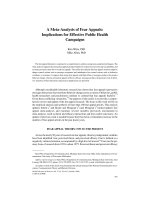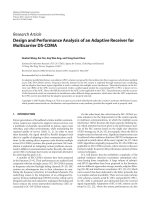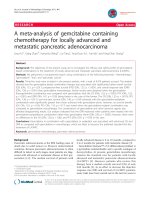Decadal analysis of efficient cropping zone for cotton crop in Tamil Nadu, India
Bạn đang xem bản rút gọn của tài liệu. Xem và tải ngay bản đầy đủ của tài liệu tại đây (334.9 KB, 5 trang )
Int.J.Curr.Microbiol.App.Sci (2020) 9(7): 3840-3844
International Journal of Current Microbiology and Applied Sciences
ISSN: 2319-7706 Volume 9 Number 7 (2020)
Journal homepage:
Original Research Article
/>
Decadal Analysis of Efficient Cropping Zone for
Cotton Crop in Tamil Nadu, India
Rajashree Khatua*, S. Panneerselvam, V. Geethalakshmi, M. Kumar and P. Jeyakumar
TNAU, Coimbatore-641003, India
*Corresponding author
ABSTRACT
Keywords
Efficient cropping
zone, Most efficient
cropping zone, Less
efficient cropping
zone, Inefficient
cropping zone,
Relative spread
index and Relative
yield index
Article Info
Accepted:
22 June 2020
Available Online:
10 July 2020
Tamil Nadu traditionally grows cotton in an area of about 0.2m hectares and
produces about 0.6 million bales of cotton and because of its climate and soil, the
State is ideally suited for producing long and extra long staple cottons. This
analysis was carried out to identify the efficient cropping zones of Cotton crop in
Tamil Nadu state. An analytical study was done to identify the Efficient cropping
zones of the Cotton crop of Tamil Nadu were keyed out with 10 years data (20042015) using Relative Yield Index (RYI) and Relative Spread Index (RSI). We
were able to find out the efficient zone for cotton crop. A study was conducted at
Agro Climate Research Centre, Tamil Nadu Agricultural University, Coimbatore
during 2018-19 to delineate ECZ for the cotton crop of Tamil Nadu. It was found
that Salem and Ariyalur both come under more efficient cropping zones for cotton
crop. Most of the parts of Tamil Nadu come under NECZ and LECZ. Four
districts of Tamil Nadu are coming under efficient cropping zone and they have
more area compared to yield. Those districts are Tiruchirapalli, Perambalur,
Madurai and Virudhanager.
Introduction
Cotton, the ‘White Gold’ enjoys a premier
position amongst all commercial crops in
India. In the raw material consumption
basket of the Indian textile industry, the
proportion of cotton is around 59%. In India,
cotton productivity is very low as compared
to other countries. More than 50 percent of
the cotton area is covered by cotton hybrids
and the hybrids contribute about 60 per cent
to national production (Santhy et al., 2008).
Conversely, about 60 per cent of cotton in
India is cultivated under rain-fed conditions
and this is regarded as one of the reasons for
the low productivity recorded in the country.
Cotton is very important to the Indian
economy because it provides gainful
employment for millions of people as well as
source of foreign exchange for the country.
Cotton is grown in nine major states in three
different zones. Punjab, Haryana and
Rajasthan in north zone. Maharashtra, Gujarat
and Madhya Pradesh in central zone and
3840
Int.J.Curr.Microbiol.App.Sci (2020) 9(7): 3840-3844
Andhra Pradesh, Karnataka and Tamil Nadu
in the south zone are the major cotton
growing states in India. Tamil Nadu is the
tenth largest cotton-producing state in India
with a production of 5 Lakh Bales. Tamil
Nadu accounts for more than 6% in the total
cotton production in the country and cotton is
grown in 70,000 hectares of land in the state.
Tamil Nadu is the state in India with the
highest cotton yield, which is 1,214 kilograms
per hectare. Coimbatore, Vallalur, Madurai,
Ramanathapuram, Salem, and Tiruchirapalli
are some of the major cotton producing
districts in Tamil Nadu.
are given here under.
One such method for identifying the potential
area of crops is by calculating Relative Yield
Index and Relative Spread Index and in turn
Efficient Cropping Zone of the crops
(Veeraputhiran, 2003).
The criteria suggested by Kanwar (1972)
were used to demark efficient cropping zone
as per RSI & RYI values obtained from
computation in respect of rice, maize,
sorghum, pearl millet, black gram, green
gram, groundnut and gingelly.
In this context, a study was conducted at Agro
Climate Research Centre, Tamil Nadu
Agricultural University, Coimbatore during
2018-19 to delineate ECZ for the cotton crop
of Tamil Nadu.
Materials and Methods
Data collection: Efficient cropping zone for
cotton was studied for all the districts of
Tamilnadu. Hence the time series data
available at district level, from 2005-2015 (10
years) regarding the area, production and
productivity of cotton crop were collected
from the directorate of economics and
statistics, Government of Tamil Nadu,
Chennai.
Method adopted
The formula propagated by Kanwar (1972)
was used to find out Relative Spread Index
(RSI) and Relative Yield Index (RYI) for
each crop to identify efficient crop zone for
the selected crops in Tamil Nadu. The details
Area of particular crop expressed as per cent
of total cultivable area in the district
RSI =
x 100
Area of crop expressed as percentage to the
total cultivable area in the State
Where in RSI: Relative Spread Index
Mean yield of a particular crop in a district (Kg/ha)
RYI =
x 100
Mean yield of the crop in the State (Kg/ha)
Where in RYI: Relative Yield Index
Results and Discussion
For cotton crop, Salem and Ariyalur district
was found to be MECZ, mainly because it has
black cotton soil and also has more number of
textile industries in Tamil Nadu. The MECZ
considering as High RSI and RYI for cotton
fell with Salem (194.1/120.7) and Ariyalur
(247.1/1310).
The reason accredited for superior RSI and
RYI values in these districts for the marketing
facility which is highly pronounced in these
areas. Farmers are showing larger interest in
cotton because of normal monsoon, increase
in minimum support price and better
realization compared to other crops. The
districts Tiruchirapalli, Perambalur, Madurai
and Virudhunagar come under ECZ with low
RSI and High RYI. Though the yield potential
good, the spread is low and hence efforts
should be made mainly to increase the area of
the crop.
3841
Int.J.Curr.Microbiol.App.Sci (2020) 9(7): 3840-3844
Table.1 Criteria for Efficient Cropping Zone
RSI
>100 (High)
RYI
>100 (High)
<100 (Low)
>100 (High)
> 100 (High)
<100 (Low)
< 100 (Low)
< 100 (Low)
Cropping Zone
Most Efficient Cropping Zone (MECZ). The zone with good spread and
more yield of crop. Sustainability options have to identified and imposed.
Efficient Cropping Zone (ECZ). The zone with good spread and low yield.
The constraints in area spread have to be identified. The ECZ is renamed
as Yield Efficient Cropping Zone(YECZ) in Agro Climate Research
Centre’s Crop Scientist unpublished Report, 2018.
Less Efficient Cropping Zone (LECZ).The zone with high spread and Low
yield. The constraints in yield have to be identified.
Not Efficient Cropping Zone (NECZ). The zone with low spread and low
yield. Suitability of alternate crops may be assesed. Table
Table.2 District wise efficient cropping zone in Tamil Nadu
Most efficient cropping zone (MECZ)
DISTRICT
SALEM
ARIYALUR
RSI
194.1034
247.943
RYI
120.7003
131.0523
RESULT
MECZ
MECZ
Efficient cropping zone (ecz)
DISTRICT
TIRUCHIRAPALLI
PERAMBALUR
MADURAI
VIRUDHUNAGAR
RSI
208.6844
306.2525
167.6664
245.9479
RYI
88.99416
94.62981
71.86026
79.39764
RESULT
ECZ
ECZ
ECZ
ECZ
Not efficient cropping zone (NECZ).
DISTRICT
KANCHEEPURAM
THIRUVALLUR
CUDDALLORE
VELLORE
KRISHNAGIRI
THIRUVARUR
RAMANATHAPURAM
SIVAGANGAI
THOOTHUKUDI
THE NILGIRIS
KANNIYAKUMARI
RSI
0
0.025411
65.30319
96.53228
31.63498
35.75876
31.69282
10.53466
80.12285
0.17301
0.139495
3842
RYI
RESULT
92.3116
NECZ
25.52511
NECZ
80.87384
NECZ
97.91377
NECZ
86.81461
NECZ
94.61206
NECZ
55.52609
NECZ
96.28847
NECZ
85.0434
NECZ
99.89114
NECZ
27.67305
NECZ
Int.J.Curr.Microbiol.App.Sci (2020) 9(7): 3840-3844
Less efficient cropping zone (LECZ)
DISTRICT
VILLUPURAM
THIRUVANNAMALAI
NAMAKKAL
DHARMAPURI
COIMBATORE
THIRUPPUR
ERODE
KARUR
PUDUKKOTTAI
THANJAVUR
NAGAPATINAM
THENI
DINDIGUL
THIRUNELVELI
RSI
58.44739
10.04873
46.67407
76.55343
22.28349
6.511407
19.16124
3.495141
0.962279
15.25804
22.85143
47.35302
26.67133
63.28053
RYI
100.3695
114.1523
136.5436
114.2186
100.0914
143.3371
147.4378
111.6305
108.963
133.7913
109.8633
155.6096
127.0233
111.2945
RESULT
LECZ
LECZ
LECZ
LECZ
LECZ
LECZ
LECZ
LECZ
LECZ
LECZ
LECZ
LECZ
LECZ
LECZ
Fig.1 Efficient cropping zone for cotton (2005-2015)
Eleven districts come under NECZ with both
low RSI and RYI. Under LECZ most of the
districts comes because for low Area and high
yield like Villupuram, Thiruvannamalai,
Namakkal,
Dharmapuri,
Thiruppur,
Coimbatore, Erode, Pudukkottai, Thanjavur,
Nagapatinam,
Theni,
Dindigul
and
Thirunelveli. In order to bring ECZ areas
under MECZ for the cotton crop, improved
cultivars, advanced cultural practices, better
management practices and availability of need
based quality inputs at reasonable price must
be tried. In order to popularize the crop in the
NECZ, farmers need to be trained in
innovative technologies to explore higher
productivity, which can be done by
strengthening the extension services.
3843
Int.J.Curr.Microbiol.App.Sci (2020) 9(7): 3840-3844
In conclusion enhancing and maintaining
sustainability in crop productivity is possible
only through identification of efficient
locations for crops. The crop adaptability to a
particular region governs the productivity of
the particular crop. At present, there are two
methods to identify suitable cropping zones.
The identified MECZ and ECZ of cotton crop
could be focused for further improvement for
surmounting the demand – supply gap and
changes in cost structure in cotton production.
The districts that fall under high rainfall and
hilly zones i.e. Kanyakumari and Nilgiris as
well as Ramanathapuram which is a coastal
region were found to be inefficient zone for
cotton crop and alternate crops must be
promoted in those districts.
Some micro level constraints like seed, soil,
timely sowing, varietal multiplicity, spacing
and plant density, plant protection and IPM
adoption are the main cause for less
production of cotton in Tamil Nadu.
Considering these factors, we need to focus
on new technology and crop insurance
promoted for efficient cropping zone for
cotton crop. Considering these factors, the
crop insurance promoted for efficient crop
zone would protect the farmers from crop
losses.
Abbreviations
MECZ:- Most Efficient Cropping Zone,
ECZ:- Efficient Cropping Zone, LECZ:- Less
Efficient Cropping Zone, NECZ:- Not
Efficient Cropping Zone, RYI:- Relative
Yield Index, RSI:- Relative Spread Index,
IPM:- Integrated Pest Management
References
Kokilavani, S., & Geethalakshmi, V. (2013).
Identification of efficient cropping zone
for rice, maize and groundnut in Tamil
Nadu. Indian Journal of Science and
Technology, 6(10), 5298-5301
Sanbagavalli S, Rohini A et al. (2002).
Efficient cropping zones - decadal
analysis for major crops in Tamil Nadu,
Indian Journal of Agricultural Research,
vol 36(4), 227–233.
Thavaprakaash N, Babu C et al. (2008).
Identifying potential cropping zones for
important horticultural crops of Tamil
Nadu, The Madras Agricultural Journal,
vol 95(7–12), 418–424.
Veeraputhiran R, Kathikeyan R et al. (2003).
Crop planning climate atlas –
principles, Relative spread index and
relative yield index, A.E. Publications,
Coimbatore, 156–158.
How to cite this article:
Rajashree Khatua, S. Panneerselvam, V. Geethalakshmi, M. Kumar and Jeyakumar, P. 2020.
Decadal Analysis of Efficient Cropping Zone for Cotton Crop in Tamil Nadu, India.
Int.J.Curr.Microbiol.App.Sci. 9(07): 3840-3844. doi: />
3844









